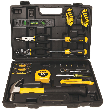Opening a Paint Can Safely
Written by Lee Wyatt (last updated March 20, 2020)
Opening a paint can safely is an important skill to have, if not for yourself, then for the world around you. For example, if you happen to be careless when opening a paint can you can very easily damage yourself (or someone near you) rather seriously. Even if you don't damage yourself or someone else, you can easily end up spilling paint all over the floor, walls, or (in cases of really exuberant openings) the ceiling. It's not all that hard to open a paint can safely, as long as you remember to follow a few simple steps.
- Prepare the area. Before you begin opening your paint cans, you really need to prepare the area you will be working in, and opening the cans in, properly. This rather simple step is more so that if you accidentally spill the paint, it won't get on anything important. The best way to prepare the area is by placing down drop cloths.
- Get the right tool. You can use a wide variety of tools to open a paint can, as given by the perennial favorite (and wrong choice) of the flat tipped screwdriver. Ideally you will want to use a specialized tool, which can be bought at most home improvement stores, and all paint stores. That tool is, imaginatively enough, called a paint can opening tool. In addition, you will also want to have a sharp knife, razor blade, or even old pair of scissors on hand just in case.
- Take a look at the can. When you have prepared the area, and have the proper tools, you need to take a careful look at the paint can. The typical paint can is going to be either in the quart or one gallon sizes, and as such often have a metallic lid. If you have a larger paint can (such as five gallon buckets) you will find that the lids are typically going to be made out of plastic. You need to know which you have so that you will know the proper method for opening.
- Carefully insert the tool. If you have a metallic paint can, you need to carefully insert the paint can opening tool into the space between the lid and the edge of the paint can. Carefully begin prying the can open. For a plastic bucket, you will have noticed that there is a plastic strip that runs its way around the bucket that holds it all together. This will need to be removed. With it removed, you can then begin inserting the paint can opening tool, and again prying the bucket open.
- Work your way around the can. Once you have lifted a part of the can or bucket open, you need to repeat the process all the way around the can. While some cans will allow you to get simply pop off the lid once you have broken the initial seal, many times the can will be stubborn. Work your way around the can slowly and carefully to ensure that you get it open properly.
- Lift off the lid. Once you have broken the seal around the lid of the can properly, you should be able to lift the lid off. Do this very carefully so that you don't get any paint on your hands, and set it aside paint side up. Setting the paint side up will ensure that the lid doesn't accidentally spread paint around, create a "puddle" that you can track to other places, and won't stick the lid to the drop cloth.
Now that you have the paint can open, you can get to work on your project. Remember though that even if you were able to open the paint can safely, you still need to be careful. Not only can you still spill the paint in the can all too easily, you will have to store or dispose of any left overs when you are finished with your project. While paint is an extremely useful material, it can very easily cause all kinds of problems if you aren't careful.
Author Bio
Lee Wyatt
Contributor of numerous Tips.Net articles, Lee Wyatt is quickly becoming a regular "Jack of all trades." He is currently an independent contractor specializing in writing and editing. Contact him today for all of your writing and editing needs! Click here to contact. Learn more about Lee...
Cleaning a Gas Range
I may have been living under a rock, but to me it appears that gas ranges are popping up all over the place. After all, ...
Discover More
Removing Stains from Children's Clothing
Children are without a doubt one of the great joys in this world. They seem to have this innate ability to create ...
Discover More
How to Use a Drain-and-Trap Auger
A snake can be an extremely useful tool, at least if you use it correctly. If they are used incorrectly, a drain-and-trap ...
Discover More
More Home Improvement Tips
Painting Exterior Walls
While it would be nice to think that we will always love the current color of our homes, the truth is that eventually we ...
Discover More
How to Choose Quality Brushes
As with most things, if you use low quality paintbrushes then you will end up with a substandard finished product. By ...
Discover More
Painting Tool Necessities
Just as with any task, when painting a room you will need to make sure that you have the correct tools. Surprisingly ...
Discover More

Comments